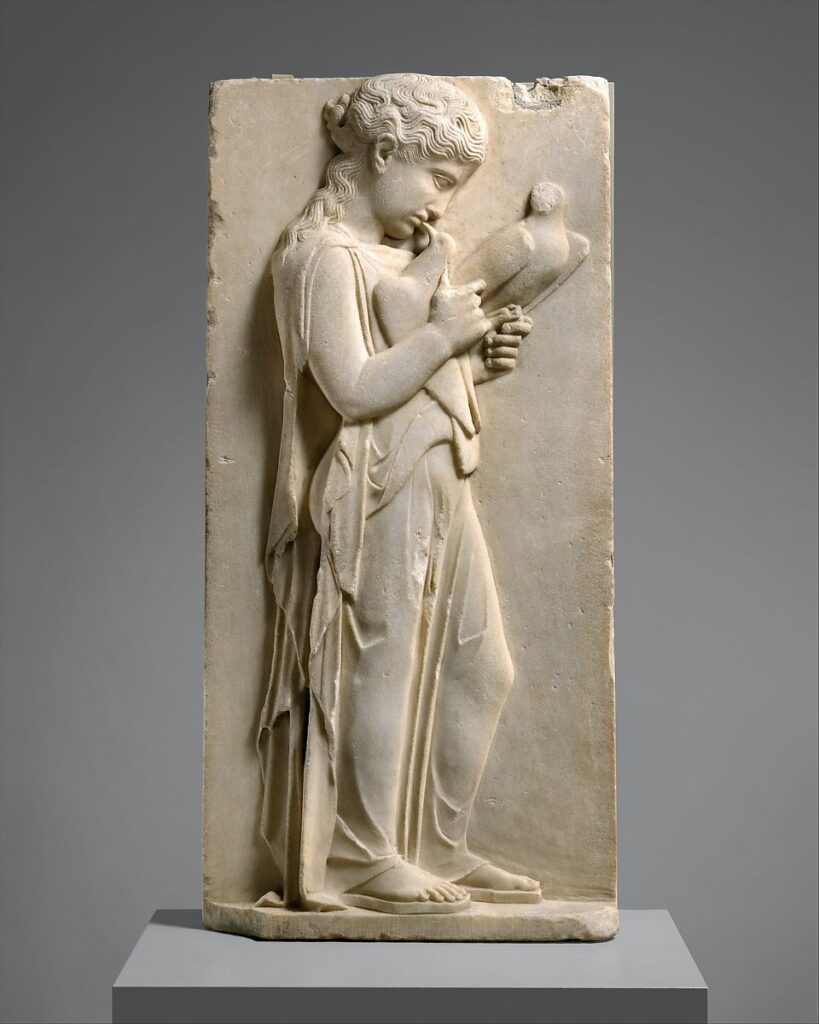Girls of the Met is a column that looks at how the Metropolitan Museum of Art is representing girls in their collections, using items that are publicly on view, and how we can reinterpret them to be more inclusive and activist in how we think about art, history, and culture. I’d love to know what you think of these reinterpretations!
Standing in gallery 156, this marble stele seems to blend with the rest. It is part of the Ancient Greek artifacts collection – often miscategorized as “art,” these are actually archaeological materials from a range of excavations dating to the early 1700s – all conducted, of course, by white men stealing other people’s history and claiming it as their own. But today, I want to talk about the stele itself – not the men who stole it, lost its context, and put it on display. As the Met explains in their object label:
The gentle gravity of this child is beautifully expressed through her sweet farewell to her pet doves. Her peplos is unbelted and falls open at the side, while the folds of drapery clearly reveal her stance. Many of the most skillful stone carvers came from the Cycladic Islands, where marble was plentiful. The sculptor of this stele could have been among the artists who congregated in Athens during the third quarter of the fifth century B.C. to decorate the Parthenon.
Link to object record: https://www.metmuseum.org/art/collection/search/252890
First off, I have to laugh – because this label does almost nothing to tell you what the object is or how it was used. So let’s start at the beginning, shall we?
Stele are wooden or stone slabs that were used as memorials or territorial markers. Found in 1785 on the island of Paros, this is a memorial to a young girl. Her clothing – called a peplos – was in fashion around 500 to 300 BCE, telling us that she died about 2,500 years ago. The Met has dated it to 450-440, right in our time range, though they don’t explain how they got that date.
What I find interesting is that the girl is holding a dove – called peristerá in Ancient Greek – which could be either her pet or a symbol of the goddess Aphrodite. Given that Aphrodite was the goddess of love, perhaps this girl died shortly before a planned marriage and the stele was erected by her betrothed. The symbolism makes sense, but it doesn’t feel quite right.
Greeks kept birds as pets, as evidenced by many written sources, who often attest that birds were a popular “first pet” for children. Birds remained important pets throughout life; for example, in Homer’s Odyssey, birds are kept by Penelope as a way to help ease her heart while waiting for Odysseus’s return. Hundreds of vases, bowls, jugs, reliefs, and figurines show girls and women with birds in ways that suggest a very strong emotional bond, just like this stele. As Kenneth Kitchell elaborates, birds were the second most common type of pet, often for the delight they brought in imitating voices or singing songs.
This stele is a testament to ancient Greeks’ love of pets, but also to their respect for their girls. Even though research shows that ancient Greek girls were not equal to their male peers, the stele made in their memory offers tangible proof of the parental – maybe even communal – love and respect held for their children.
So if we were to rewrite the Met’s label, it might go something like this:
This stele of a young girl depicts her with pet doves, like a tombstone might today. The second most common pet in ancient Greece, birds were often given to children and kept throughout life, loved for their imitations and songs as much as the sustenance of eggs and meat. Bird bones and toys are often found in ancient Greek children’s graves. However, because this was excavated in 1785 and brought back to Britain (then acquired by us), we don’t know to which grave it belongs and have lost any context that could help us better understand the girl’s life and her place in the community.
What do you think? What kind of discussions does the new label prompt that the old one left out?
-Tiffany Isselhardt
Program Developer
Girl Museum Inc.
Sources & Recommended Reading
“Peplos” from FitNYC’s Fashion History site https://fashionhistory.fitnyc.edu/peplos/
“Greek and Roman Household Pets” in The Classical Journal, 1949 https://penelope.uchicago.edu/Thayer/E/Journals/CJ/44/4/Household_Pets*.html
“Penelope’s Geese: Pets of the Ancient Greeks” by Kenneth Kitchell (Penn Museum)
https://www.penn.museum/documents/publications/expedition/PDFs/53-3/kitchell.pdf
For an alternative view on the use of doves on children’s stele, I suggest reading Brittany Garcia’s blog on the Symbolism of Birds in Ancient Greece
http://classicsnewsneedsandnow.blogspot.com/2013/11/the-symbolism-of-birds-on-ancient-greek.html

